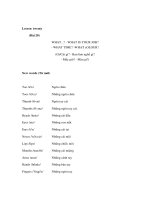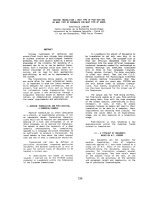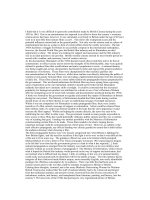What do businesses need to prepare to participate in trade fairs?
Bạn đang xem bản rút gọn của tài liệu. Xem và tải ngay bản đầy đủ của tài liệu tại đây (98.55 KB, 11 trang )
Contents
1.1. What is a trade fair
1.2. Concept:
According to the Commercial Law of the Socialist Republic of Vietnam, trade fairs
are defined as follows:
-
The trade fair is a concentrated trade promotion activity in a short time and at a certain
place, in which production and business organizations and individuals may present
their goods for marketing and signing commodity trading contracts.
1.3.
Characteristics:
The object
-
These are commercial activities carried out by businessmen.
-
If other trade promotion acts can be conducted by individual independent traders, trade
fairs can only be conducted with the simultaneous participation of many traders at the
same time and place.
How to organize
-
Traders can directly organize. Or through a service contract to organize fairs.
-
Trade fairs held in Vietnam must be registered and certified in writing by the state
management agency in charge of commerce of the province or centrally run city where
the event is held.
-
For trade fairs are held abroad. When organizing other traders’ events, traders
providing trade fairs services must register with the Ministry of Industry and Trade.
Regulations on goods and services at trade fairs
For events held in Vietnam, goods and services participating in trade fairs are sold
on the spot as normal trading activity and they must:
-
Not subject to the business ban, business restriction, not yet allowed to circulate
according to the provisions of law;
-
Not subject to import ban as prescribed by law. (for goods and services provided by
overseas traders);
-
Not counterfeit goods, goods are infringing intellectual property rights, except for
display and introduction to compare with real goods.
-
For goods temporarily imported for re-export for re-import. To participate in the fair,
the purchase, sale, and donation of the above goods without re-exporting or reimporting must comply with regulations on customs procedures, import and export,
tax, and other financial obligations.
1.4.
-
Distinguish trade fairs from trade shows:
Trade shows are similar in appearance to fairs, but businesses cannot bring goods to
sell at the exhibition. Enterprises participate in trade shows mainly to introduce,
advertise, and trade to facilitate the signing of economic contracts. Trade shows are
often less periodic than trade fairs.
-
Today, trade fairs and trade shows are trade promotion activities that tend to develop
strongly. However, trade fairs and trade shows are rarely organized separately, but they
are organized in coordination with each other at the same time.
II.
The benefits of organizing a trade fair
For organizers.
- When participating in trade fairs, companies will have to pay any fees such as venue
Costs, Booth Setup and Accessories, Marketing, Insurance, and Legal Fees,... from
which The organizers can gain a lot of profit.
- Trade fairs are also a great place for organizers to form partnerships with competent
and reliable operations.
For business.
- Competition based on quality has dramatically intensified in recent years, along with
the pressure to innovate, grow and succeed in the global economy. Trade fairs
provide an ideal platform for demonstrating innovation and tackling competition.
- For most companies, participating in trade fairs helps them to get a comprehensive
picture of the range of products and services on offer as well as price/performance
ratios and market trends, helping to steer them towards future business success and
forge business relationships.
- The high numbers of visitors make trade fairs one of the most effective means of
communication, which presents an opportunity for companies to build on existing
customer relationships and boost customer loyalty to their business. Besides,
Customer requests from dialogue with visitors are extremely helpful for improving
products and services.
- Trade fairs are an affordable way for small and medium-sized companies in particular
to access international markets.
For attendees.
- Trade fairs allow attendees to meet the seller directly and see a variety of products
with their own eyes, which provides them with more options at an affordable price.
By actively testing products at the trade fair, attendees can see for themselves their
functionality and quality. Thus, they can easily evaluate the most satisfactory
products.
III.
What do businesses need to prepare to participate in trade fairs?
III.1. Determining the objectives of organizing the fair
-
To make a product successful, the first thing must always clearly define the objectives
of the booth you intend to participate in. In particular, the booth must be in line with
the general theme of the whole exhibition. You must refer to the documents about the
fair. Contact the fair organizers to collect the necessary data. For example, the number
of exhibitors, the number of customers, the countries participating in the fair ...
-
Businesses need to come up with the appropriate budget for the fair, must study
whether the fair venue attracts the group of people that businesses want to target, and
must learn more about the types of fairs that the business intends to organize.
-
In addition, businesses should also refer to the fairs that have been successfully
organized before, contact the fair organizer to collect specific data on the number of
exhibitors, the number of customers, the total exhibition area, the venue,... and most
importantly in this stage is to clearly define what the fair wants to target the item?
Relevant businesses and exhibitors will come here to showcase and display at the fair.
III.2. Operation plan
After having achieved the goal of organizing the fair, businesses should plan to operate
the fair most smoothly, this is a very important thing to help participants, exhibitors
will know the plan to implement the work effectively.
-
Depending on the level and industry, the business will have different plans. Enterprises
should contact the organizer as soon as possible so that they can make appropriate
plans, as well as carry out necessary procedures such as applying for a license
-
to organize fairs, renting venues, hiring personnel,...
In addition, the development of a plan such as a start time of the fair, the end time, the
development strategy and promotion of the organization of the fair to everyone,...
Businesses should also have diagrams of booths for exhibitors to participate in so as
-
not to waste time searching the layout of the booths.
For each fair event held, it is very important to get information from customers as well
as feedback, so businesses should have a separate area to both support new visitors
who are still in difficulty, and maybe the last place visitors visit after visiting all the
booths. This both helps businesses to grasp the information and feedback from
customers, as well as be able to learn from the experience for the next fair.
III.3. Selection of booth standing personnel
-
Selecting personnel must ensure the criteria: knowledge of the product, knowledge of
the company, good communication ability, convincing customers, good looks ... It may
be necessary to train them on the company's development strategy and knowledge of
the market. Poor personnel choices may not be successful even if the company's
reputation is reduced. 85% of the fair's success is dependent on the person standing at
the booth.
III.4. Plan effective communication
-
Communication planning is one of the most important jobs for the business. With
diverse and different requirements, the planning patterns also change. Each
event will need different options, but the process will remain the same when the
business will have to communicate before, during, and after the fair. The theme or
message of the fair needs to be communicated by the objectives and strategies of the
business when organizing the fair. Businesses should also clarify what their target
customers are so that they can come up with options to deploy and reach them more
easily.
In general, a trade fair requires very careful preparations. There must be a plan from
before joining until the end. Especially contacting customers after the end of the fair.
This is an important step to get back results and orders.
IV.
How to market effectively at the trade fair?
Business trade fairs or other exhibiting opportunities present a wealth of
opportunities to promote businesses, brands, and your products and services. They
are also a great way to interact and engage face-to-face with current and potential
customers. Therefore, to effectively market from trade fairs, businesses need to:
• Attention: Attract attendees to your booth through banners, banner stands, giveaways,
contests or prize drawings, literature, and interactive elements such as touch screens
to gather customer information, demonstrate a product, or conduct a survey. Choose
a unique theme for your booth and make it interesting, fun, and engaging. Key sales
and marketing messages, eye-catching signage, informative literature, appealing
giveaways, and engaging elements will generate a higher volume of booth traffic.
• Research: While it is important to thoroughly plan your trade show booth, it is equally
as important to conduct some research long before trade shows take place. Determine
which trade shows are appropriate for your business sales and marketing goals.
Carefully evaluate the details of each trade show including the number of businesses
who exhibit, the average number of attendees (potential customers), attendee
demographics by job function, and so on. If possible, interview businesses who have
exhibited in past years, and ask for their feedback and opinions about the event.
Exhibiting at trade shows can be costly. You need to research all details and gauge
which trade shows will yield the highest return on investment.
• Objectives: Set objectives for yourself and your trade show booth staff. Create a list of
objectives in order of their importance. Staff discussions should yield methods of
achieving those objectives and help everyone to focus on achieving the most
important ones. Examples of objectives could be: collect “X” number of sales leads
with a leads qualification survey; coordinate “X” number of sales demonstrations; or
gather research on competitor brands.
• Publicity: Advertise your attendance at the trade show through a direct mail piece to
confirmed attendees (or a targeted list drawn from the list of confirmed attendees);
and announce it on your website, through email campaigns, in newsletters, on your
blog, through social media sites, and in email signatures. If you plan to hold a
contest or prize draw to attract more people to your booth, be sure to advertise that
too. Let everyone know where your booth will be located so they can find you easily.
• Contests: A contest or prize draw is a great way to attract people to your booth. When
advertising your attendance at the trade show, ask attendees to visit your booth to
complete a leads qualification survey and be entered into the contest or prize
drawing. Choose a prize that relates to your business, products, or services; or a prize
that has broad appeal to your current and potential customers. For example: if you
sell survey software or survey research services, the prize could be a device to
administer surveys such as an iPad or a tablet PC to conduct mobile surveys; or the
prize could be a copy of the survey software so the winner can create and administer
their surveys. This is a great way to gain prospective customers. Follow-up with all
contacts shortly following the trade show.
• Preparation: Be sure to bring a good amount of supplies to the trade show so you do
not run out of important literature, brochures, business cards, and giveaways. Review
your research to know the number of attendees. Calculate a percentage of those
attendees who may visit your booth and bring that number of materials. Realistically,
not every attendee will visit your booth. Additionally, generate enthusiasm with all
staff that will be representing your company at your booth. Make sure they are
knowledgeable about the company, current and new products and services, market
trends, and competitors, so they can carry on an intelligent conversation with
prospective customers. Encourage them to interact and engage with attendees, gather
contact information with the leads qualification survey, and visit competitor booths.
V.
Conditions for success when participating in trade fairs.
-
Currently, businesses often participate in displaying their products at trade fairs. This
is considered a marketing tool to customers to help the customers know more about the
most complex marketing tools of all. Because it involves multidimensional
communication, there are many points at which adjustments can be made that will
have a decisive influence on the factors determining success. In practice, preparing to
attend a trade fair is often not a major priority, especially in small and medium-sized
companies, because no specific resources have been allocated to it. In consequence,
we see that at least some of the potential of the trade fair as a platform for
-
communication and acquiring new customers remains unexploited by companies.
In the following, we present four conditions to help enterprises succeed when
attending the trade fairs.
V.1. Clear the aims of participation in trade fairs
-
It’s important to have a clear understanding of your goals at the trade fairs. Once you
identify this, you can work effectively and efficiently towards that goal. They should
strive to make your goals specific and realistic, clear and measurable. Goals will also
help you choose the right trade fair. The goal of a company at a fair is to meet new
customers in addition to taking care of them by building on existing business
relationships. Especially helping partners to raise awareness of the company, thereby
accessing and presenting new products and services to create export orders. Thereby
helping businesses open up new markets and expand joint venture partnerships.
Outlining and coordinating goals will make all involved more willing to accept. The
sales department pursues goals other than product marketing and product development
goals. Therefore, it may cause conflicts in the process of participating in the
exhibition. To avoid these conflicts and to decide on a unified approach for all fair
participants, we recommend holding a kick-off meeting involving all departments in
the industry. company. The function of this meeting is to establish goals and objectives
because the way they are defined will determine the plan for the company's presence at
the fair - from booth layout, function and design of it, and the selection of exhibits to
the visitor's decision. invitations and deals with guests in the stands. Finally, goals can
be used to measure post-trade success.
V.2. Make a detailed preparation for successful participation in the trade fair
-
Another key to success is a thorough preparation for the trade fair. First, businesses
need to prepare a plan to meet new customers and take care of existing customers.
From there, based on the set goals, make a budget plan to make a participation
decision. From there, the enterprise establishes a project team and commits to
achieving the goals. Businesses need to anticipate a preparation time of at least 12
months and need to have a checklist and set deadlines. Even if the people in the
company who are responsible for attending a trade fair are not required to produce a
report on the necessary finance, clear budget planning and control nevertheless
represent an added value. In this way, planners are clear about the cost structure of
taking part. The realistic calculation of a budget creates a solid financial basis for a
company’s participation in a fair. Rough estimates, guesstimates, or picking a number
out of the air often lead to compromise solutions that can put the aims in danger.
That’s why it is crucial from the outset to have a reliable overview of the costs that
will accrue. To keep the budget for exhibiting at a fair as low as possible, the business
should have early planning means saving cash. Short-term changes or last-minute
orders could lead to a rise in the charge. Regular coordination with the whole team
ensures you’ll keep to the budget.
V.3.
-
Visitors marketing
Fair organizers invest a large portion of their budget in fair advertising, and they
ensure that a large number of professional visitors attend the fair. However, this does
not automatically mean that these visitors contact all the businesses that are relevant to
them. So, in the case of large-scale fairs, businesses need to engage in marketing their
presence at the fair and they must draw the attention of potential guests to their
presence. Businesses should send invitations to their potential visitors as one of the
most effective tools for guest marketing. Based on that, the enterprise compiles a list
of potential customers by checking: The database at the trade fair website, and the
relevant international business directory, which lists the members of some relevant
industry associations in the company's preferred market. When your business attracts
them, a representative of the joint venture company will come to inspect and pay
attention to visit your booth. After careful consideration by the customer, the joint
venture company can proceed with the transaction and sign the contract.
V.4. Train your staff professionally
-
The most luxurious trade fairs stand and innovative products require booth staff to be
prepared to handle inquiries in person, even online. Trade fair training on
communication techniques and language skills is essential. English skills are a must at
international trade fairs. In addition, at major international trade fairs with the
participation of many countries, having employees with multi-language skills is also a
great advantage. Furthermore, all employees in that company know the most important
data knowledge related to their products. If there is only a single product specialist on
the site, the backlog can quickly grow if they have to answer all the questions from
multiple interested parties at once. Therefore, businesses need to arrange enough
employees in different positions. For example, a sales position needs to be trained in
communication skills and effective sales skills in line with the original goals of the
business. Or, product marketing staff must be trained in product expertise to support
customers in the process of approaching products to find new markets for enterprises.
VI. The situation of organizing trade fairs in Vietnam recently.
-
After two years of being deeply affected by the epidemic, many activities of the
economy have been affected, which is likely to affect and it's a challenge as we've seen
and it will probably affect us for a considerable amount of time. Trade fairs are very
different from focus events other. It's the best place to do business where now the
broader industry continues to tightly control Strict conditions and situations to manage
-
risks of COVID-19.
2022 creates positive confidence because of changes in the Government's disease
prevention policy, along with widespread vaccine coverage and the plan to open twoway international flights, which will open up many opportunities for the community.
domestic and foreign enterprises. The 31st Vietnam International Trade Fair VIETNAM EXPO 2022 with the theme "Accompanying businesses in the digital era".
This is an event marking the recovery and breakthrough of Vietnam's trade fair
industry in 2022 in particular and trade promotion activities in general.









